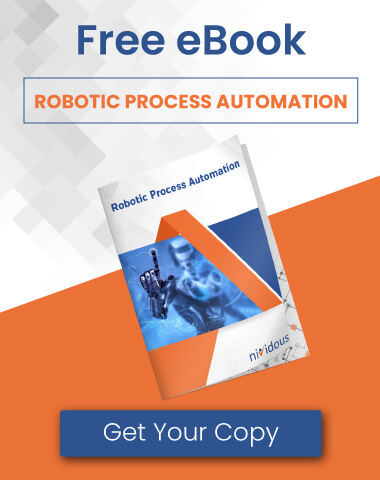In the era of rapid Artificial Intelligence (AI) developments, Robotic Process Automation (RPA) emerges as a practical starting point for companies aiming to streamline operations, enhance efficiency, reduce costs, and maintain competitiveness.
RPA introduces a transformative approach to handling mundane, rule-based tasks across diverse functions. Picture this: data entry, invoice processing, and routine data transfers are seamlessly executed by software robots, freeing up human resources for strategic and creative initiatives.
According to a recent Grand View Research Inc. report, the global RPA market is projected to reach USD 30.85 billion by 2030, with an anticipated CAGR of 39.9% from 2023 to 2030.
Embracing RPA transcends being merely a choice; it represents a strategic move toward a future characterized by agility, efficiency, and innovation.
Industry-Specific Robotic Process Automation Case Studies
We’ve curated a concise collection of robotic process automation case studies, drawing from our experiences working with clients at Nividous. Regardless of your industry or the specific process you aim to enhance, you will likely find relevant examples of robotic process automation case studies below.
Reach out if any of the RPA success stories below resonate with you—or if you have a completely different idea!
RPA Case Studies in Manufacturing
1. The process: Invoice processing for external vendors
The problem: A leading manufacturer was struggling to process hundreds of invoices from multiple vendors each month.
The format of these scanned/digital invoices significantly varied among the vendors; more than four full-time employees were manually transcribing data from these invoices into SAP, which considerably delayed the processing. The end-to-end process was further delayed due to several hierarchical approvals.
The solution: Nividous Smart Bots were deployed to automate time-intensive and manual operations involved in processing invoices. The Smart Bots read and understand data from several types of semi-structured and unstructured scanned and image-based documents, present the extracted data to users via an intuitive interface, and feed them into SAP.
This solution significantly expedited invoice approvals and can be easily scaled up to manage an increasing number of invoices.
2. The processes: Back-office operations
The problem: A high-tech manufacturer facing fierce competition needed to accelerate time-to-market, but its highly skilled employees were spending a considerable amount of time performing manual processes across multiple systems.
Job requisitions, purchase orders, contract compliance, invoice reconciliations, and customer requests were all incredibly time consuming processes that involved multiple unintegrated systems. Redundant verifications further amplified the problem and negatively impacted the success of product launches.
The solution: To solve the numerous back-office operations issues, the manufacturer automated more than 20 business processes over time via the Nividous platform. RPA Bots were deployed within 10 days to automate the job requisition process, enabling annual savings of more than $90,000.
Invoice reconciliation and shipment tracking processes were also automated. As a result of these measures, the manufacturer realized a 40% reduction in total operating costs.
Ready to unlock the potential of Intelligent Automation in manufacturing?
Watch our expert-led on-demand webinar and discover how AI, ML, low-code automation, and RPA are reshaping manufacturing operations and driving unprecedented efficiency.
RPA Case Studies in Banking and Finance
3. The process: Daily closure for letters of credit
The problem: A fast-growing bank was heavily dependent on manual labor for processes related to issuing, managing, and closing letters of credit. Each day, users engaged in the time-consuming task of manually identifying the records expiring that day for processing closures.
They were required to complete different logic and rules-based inquiries for each record on the core banking system and determine if the closure could be executed; exceptions required a different set of rules.
The solution: The Nividous platform automated the daily closure process for letters of credit to provide a frictionless trade finance experience. An RPA Bot now logs into the core banking system to identify the records expiring that day and transcribes that information into an Excel file.
The Bot is trained to run rules-based inquiries for each record on the core system to determine if the closure needs to be processed. It also handles the exceptions using specific rules and updates the status in the Excel file.
The Bot then completes the closure process based on pre-defined logic and conditions, updates the status in the Excel file, and notifies users via email.
4. The process: Loan disbursement
The problem: A growing bank faced problems with its business loan process, primarily due to internet connectivity issues among remote staff. Those branches experiencing internet problems had longer turnaround times and difficulty with document collection and approvals.
In addition, the entire loan disbursement process was being conducted manually, leading to errors and further delays and negatively impacting the customer experience.
The solution: The Nividous team worked alongside the bank’s business and IT departments to create and implement a centralized automated business process management system for loan disbursement. It was built into the bank’s existing IBM business process management system.
The team also integrated an interface for handheld devices (mobile and tablet) for remote bank staff to capture customer data and essential documents offline and synchronize it later with a centralized server. These efforts led to a 78% reduction in turnaround time for loan processing—and a 20% increase in business.
Locating Automation OpportunitiesNot sure where to look to apply automation at your company? Check out our matrix of the most commonly automated processes across functional areas. While not an exhaustive list, it shows the areas where the majority of our clients have found automation to be most helpful. In general, processes that are good candidates for automation:
|
5. The processes: Payment posting and bank statement reconciliation against QuickBooks
The problem: A leading payee services provider in the US identified two highly labor-intensive processes as the prime candidates for RPA automation: a) payment posting process: employees manually processed ~150 bill documents daily, classifying and validating data before making the payment.
The process posed a high risk of errors. b) bank statement reconciliation: employees performed several checks manually, which led to increased process TAT.
The solution: The company automated both processes using the Nividous platform. Nividous Bots now perform several tasks involved in payment posting, from data retrieval, document sorting, and information extraction to review and approval. This automation has reduced the process TAT and human effort by 67% and 83%, respectively.
The Bots also handle all manual tasks, such as downloading statements from bank portals, validating data between statements and QuickBooks, and reconciling around 70 accounts monthly, significantly improving the reconciliation process’s efficiency.
Are you ready to transform financial services with AI and automation?
Watch our expert-led on-demand webinar to learn how AI and intelligent automation are transforming payment processing.
6. The process: Insurance payment through IVR calls
The problem: A digital insurance payment provider in the US had a manual process involving 50 call center agents making ~2000 IVR daily calls to insurance carriers to process payments. The process required dealing with sensitive information such as PII and PCI, which posed a high risk of error.
The solution: The Nividous intelligent automation platform helped the customer automate the end-to-end process, including payments, enabling zero downtime, >500 monthly savings of man-hours, and improved process TAT by over 30%.
7. The process: Insurance premium payment on InsurPay Portal
The problem: The operations team of the digital insurance payment provider manually processed 500 daily insurance premium payments for multiple companies, fetching customer details from the Insure Pay portal and validating them against 25+ carriers’ websites with complex business rules.
The solution: The end-to-end process was automated with the Nividous platform. The Nividous RPA Bot navigates the Insure Pay portal and carriers’ websites, validating payments by applying multiple business rules. The Bot then generates a virtual card, makes payments, and logs all exception scenarios that may happen at any stage for the team to review.
The company now processes over 1600 insurance payments daily, marking a significant increase of 220%, with one hundred percent accuracy. This improved process efficiency has allowed their operations team to concentrate on more critical tasks.
RPA Case Studies in Healthcare
8. The processes: Patient data extraction, patient data review, patient claim submission
The problem: A specialty healthcare management company wanted to improve its patient experience by streamlining its back office operations. Patient data lived on disconnected systems, and documents received by fax or scan were highly unstructured, unclear, and sometimes illegible.
More than 10 employees were required to manually extract and review patients’ data. This process was highly prone to errors and delayed claims processing and payments.
The solution: Within two weeks, Nividous developed and deployed RPA Bots with cognitive capabilities to automate the data extraction, data review, and claim submission tasks, streamlining the entire process from beginning to end. The company was able to reduce the handling time of its claim submission process by 70%.
9. The process: Claims processing
The problem: An eyecare practice experiencing rapid growth was struggling to manage various islands of information systems. Daily manual processes, including eligibility checks for patients coming through scheduled appointments and claims management across 40+ insurers, were demanding significant involvement from skilled employees, taking nearly 30% of their day.
The time-consuming processes caused unnecessary delays and cash flow issues. There was also a high risk of missing out on revenue due to inaccurate insurance information.
The solution: The Nividous platform automated a series of cross-functional operations involving doctors and administrative staff. As a result, highly skilled staff members now save more than 37,000 hours annually on claims processing, and the claim-to-cash time period has been reduced by nine days.
10. The process: Medical coding and billing
The problem: A healthcare group providing medical services to patients in long-term and assisted living facilities wanted to speed up its coding and billing processes to ensure faster and more accurate Medicare payments.
Its old process required dedicated skilled coders to manually analyze clinical documentation (charts and notes) and determine the codes relevant to a specific case. With more than 70,000 codes in different categories, the process of generating invoices was highly tedious and time consuming; it was also prone to error, resulting in rejected claims.
The solution: AI-powered RPA Bots are now deployed to code thousands of charts on a weekly basis with ease and efficiency. The Bots with native machine learning capabilities understand and analyze each patient’s documentation to create billing codes that are then used to create proper invoices.
This automation has reduced manual work by 95%, improved coding accuracy by 90%, and sped up processing turnaround time by 85%.
11. The process: Patient appointment scheduling
The problem: A leading eyecare group undergoing an aggressive expansion phase was struggling to meet customer support expectations. A call center was the key channel for appointment booking, and recent growth demanded a significant increase in agent headcounts.
Unfortunately, the inflexible system used by the call center did not provide the necessary APIs for third-party system integration, limiting the group’s ability to provide customer service through any other channel.
The solution: Voice and chat-enabled RPA Bots were created and deployed to serve patients in appointment scheduling.
Patients can now interact through a voice or chat Bot—accessed via Google Assistant or the group’s website—to locate the nearest store, locate the status of an order, and quickly make or change appointments. Now, 50% of appointments are made via chat Bot, and 35% fewer full-time employees are needed to handle these types of requests.
RPA Case Study in Insurance
12. The process: Premium calculations
The problem: An insurance company’s sales process for its Liability Insurance Portfolio involved hours of complex, Excel-based premium calculations.
Initially, they were using a web form to collect information and emailing that information to a staff member, who then created a customized quote. The time commitment required for these calculations prevented precise and rapid customer service and resulted in lower conversion rates.
The solution: RPA Bots simplified this complex manual premium calculation process by automating the company’s dynamic pricing model, creating custom quotes within seconds.
This quick turnaround time allowed them to offer quotes directly to end customers in addition to going through their normal channel of partners/brokers. This opened up a new path to revenue for them that did not exist before.
RPA Case Study in Telecommunications
13. The process: Procure-to-pay process for vendors
The problem: A telecommunications company wanted to improve its processes for site procurement and vendor payment, which were highly manual, time-intensive, and error-prone. Users had to manually generate and update various information related to site allotment, purchase orders, job status updates, progress reports, and invoicing.
SAP lacked a standardized format to store such data, and both internal users and external parties had to navigate through multiple discrete systems to access information.
The solution: Nividous standardized the end-to-end process within the SAP system to enable enhanced process visibility. Further, RPA Bots were deployed to automatically perform Outlook, Excel, and web processes, reducing the average process handling time by 35%. Suppliers also gained better visibility into order and payment statuses thanks to the new process.
RPA Case Studies in Logistics
14. The process: Sales order creation
The problem: All Chemical Transport Corp., the logistics company, started its automation journey with its sales order creation process.
The process was highly manual and labor-intensive. Upon receiving a work order over an email, the user had to process the request manually by logging into the internal system and filling relevant data into lengthy forms to create a sales order. It also took much work to track the status of the sales orders.
The solution: Nividous’ proprietary IDP solution was deployed to automate the end-to-end process, from reading work orders, entering data in the internal system, and creating a sales order to sending an automated daily summary report. The automation solution enabled the company to achieve greater data accuracy with improved process TAT.
15. Cross-functional business processes
The problem: Upon successfully automating its manual sales order creation process, the company wanted to scale the use of the Nividous platform. The company identified several other business processes from different departments that were manual, time-consuming, and ripe for automation.
There was a vast scope to save thousands of man-hours and eliminate manual errors using the platform.
The solution: The Nividous team worked closely with the company to identify potential areas for automation that can deliver higher ROI in a shorter period. The goal was to quickly scale the automation solution while bringing down the total cost of ownership.
The company achieved 35% yearly growth without additional administrative overheads, automating the following cross-functional processes:
- Preparing new order reports for print
- Delivery expense report generation
- Accounts payable and tolls violation
- Accounts receivable report generation
- Rating CSI process
- Batch order update
- Invoice processing
- Owner-operator delay report
- Commodity data validation
16. The process: Letter of credit amendment and shipping documentation
The problem: A prominent logistics company in India had a team of ~12 people to manually review and verify ~25 documents daily, including letters of credit, sales orders, bills of lading, load reports, and packing lists.
These documents, received at various intervals from sales order generation to consignment delivery, demanded accurate validation against multiple systems using complex business rules.
The solution: Nividous Smart Bot, equipped with native artificial intelligence and machine learning capabilities, was deployed to automate both processes.
Letter of Credit (LC) amendment: The Smart Bot identifies LC documents in emails, extracts attachments, reads data from both the LC document and ERP system, validates using business rules, and displays color-coded results on the portal for user review. Users can input required amendments on the same interface, and the Bot sends correction suggestions via email.
Documents validation: The validation of Bill of Lading, Load Report, Insurance, Certificate of Origin, and Pre-Shipment Inspection Certificate documents is now automated with an on-demand Bot. The complete solution has enabled the customer to save over 890 man-hours per month and reduce human dependency by 80%.
RPA Case Studies Across Industries
17. The process: Configuring security devices and troubleshooting alerts
The problem: A leading conglomerate uses the Genetec security application to configure and troubleshoot its surveillance devices across hundreds of sites situated at various locations. The processes to configure new devices and troubleshoot the devices having network connectivity issues were completely manual and time-consuming.
The solution: The company automated both processes with the help of the Nividous platform.
Configuration of new devices: The Nividous Bots perform a series of tasks on-demand. The Bots check emails for device setup details, create users and sites in the Genetec application, and perform required steps to configure those devices, namely video units (security cameras), and automatic doors based on predefined rules for access roles and groups.
Troubleshooting security alerts and warnings: Earlier, a dedicated person had to manually troubleshoot 200-300 video units/cameras daily to resolve network connectivity issues, which is now completely automated by the Nividous RPA Bot.
The Bot downloads a real-time report from the Genetec application every 2 minutes to identify video units/cameras flagged with warnings/alerts and performs necessary steps for troubleshooting, including rebooting.
The Bot sends a summary report to the user and makes the data (such as the number of devices with warnings and success) available in the Nividous Control Center dashboard. The same process is implemented for the automatic doors.
What are the limitations of RPA?
While RPA undoubtedly transforms mundane and rule-based tasks, it comes with limitations – you may have gotten the hint of it while reading through the extensive list of robotic process automation case studies described above. RPA excels at repetitive and structured processes but needs help with unstructured data and complex decision-making scenarios.
Its inability to adapt to dynamic environments and handle cognitive tasks hinders its effectiveness in evolving business landscapes. Moreover, RPA handles tasks within predetermined workflows, needing more cognitive abilities to understand nuances and make independent decisions.
The application of artificial intelligence (AI) and more advanced automation technologies has become paramount to address the limitations of RPA. AI brings cognitive capabilities to automation, allowing systems to understand natural language, make decisions based on patterns, and handle unstructured data with finesse.
AI-powered intelligent automation solutions empower businesses to broaden the scope of process automation. These solutions can effortlessly learn, adapt, and optimize processes autonomously, providing organizations with enhanced efficiency and adaptability.
By incorporating AI-driven automation, businesses can unlock new realms of scalability and innovation, addressing the limitations that traditional RPA might encounter in today’s dynamic and data-rich business environments.
Read this blog that talks about key differences between RPA and Intelligent automation.
Moving Beyond RPA Automation with the Nividous Platform
The Nividous Intelligent Automation platform helps businesses to move beyond siloed automation by providing a comprehensive combination of technologies that are native to the platform.
The suite of intelligent automation technologies namely RPA, AI, and low-code process automation not only allow for a seamless end-to-end automation but also significantly brings down the total cost of ownership.
Take the first step toward automation at your company.
See the intelligent automation platform that made all these robotic process automation case studies possible.





